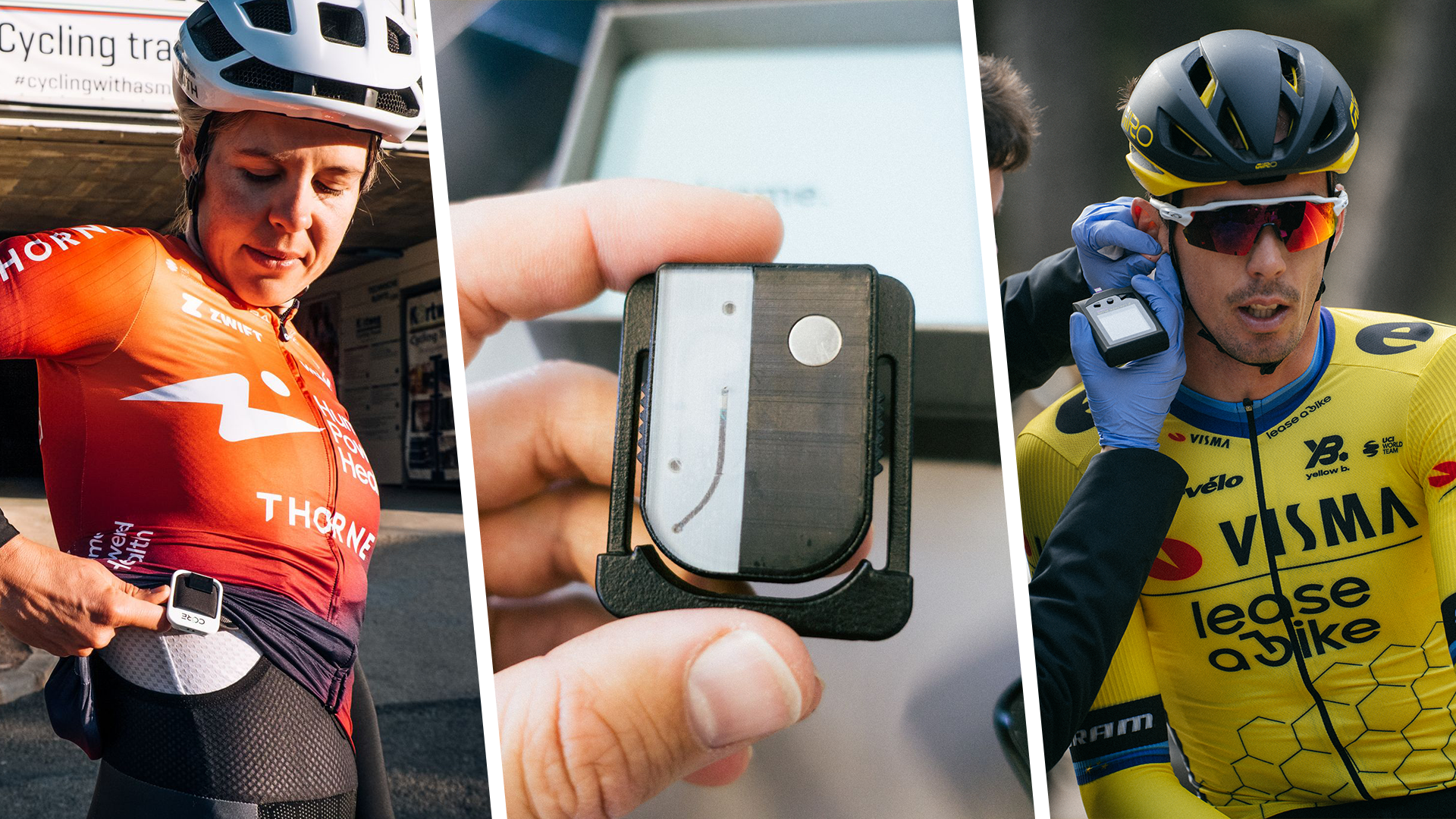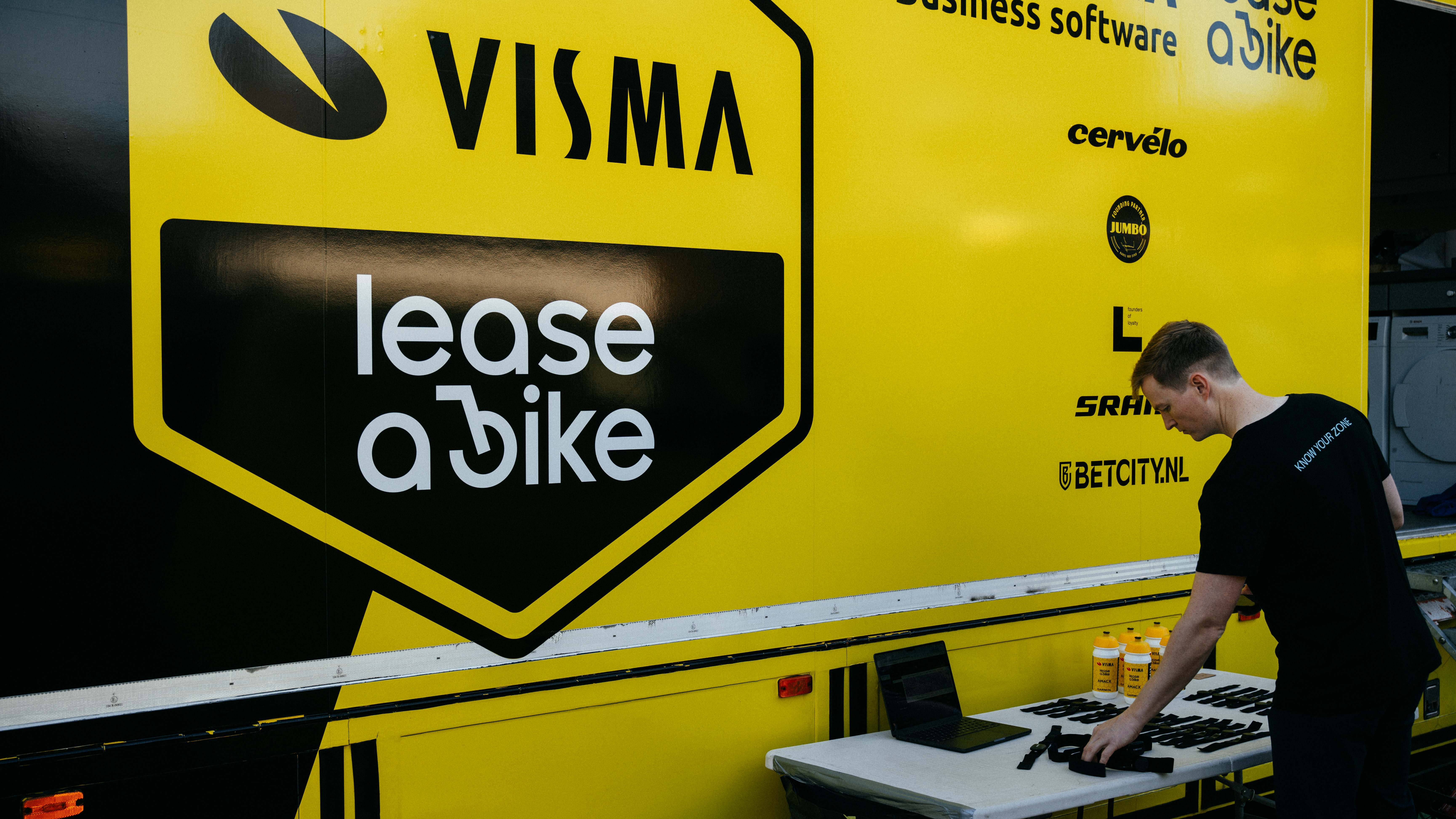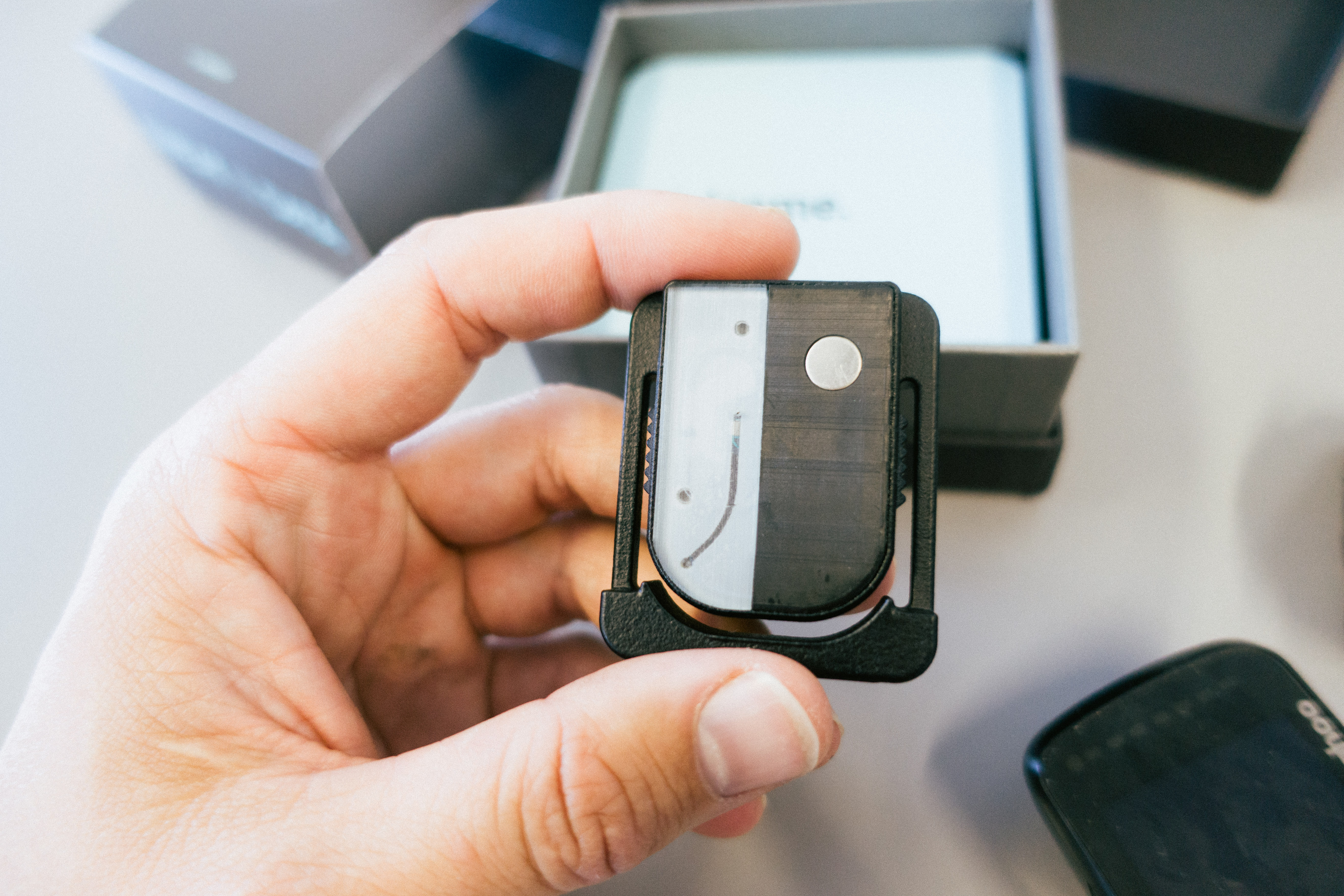
Heart rate and power data have been at the forefront of cycling performance data for many years, but there’s a cacophony of new wearables on the market which can track much more.
The peloton is awash with monitors which measure body temperature, hydration levels, sweat rates and breathing rates on the go.
Unlike heart rate monitors, these devices protrude out of jerseys, with many noticing that Pauline Ferrand-Prévot won the Tour de France Femmes while wearing a breathing sensor.
Team Visma-Lease a Bike teammate Jonas Vingegaard has also been seen sporting one, while Tadej Pogačar has previously been spotted wearing a body temperature sensor.
These new wearable sensors are now in the foreground and are driving a thirst for marginal gains.
UCI competition rules
Currently, the UCI allows several physiological sensors in competition, which include heart rate, sweat and breathing rate. All permitted sensors do not require insertion into the skin but instead sit directly on it.
The Tymewear breathing sensor was approved for use in competition just before the Tour de France this year. The sensor comprises a chest strap, a heart rate monitor and a strain gauge, which measures breathing rate.
Tymewear has a partnership with Team Visma-Lease a Bike, hence Ferrand-Prévot wearing its VitalPro strap.
"UCI were going to ban it, and then we were able to thread the needle because we're not directly measuring any metabolic markers," explains Arnar Larusson, co-founder and CEO of Tymewear.
"We're not directly measuring CO2, we're not directly measuring oxygen consumption, and we're not directly measuring lactate. We're measuring the ventilation, which is the airflow in and out of the lungs and that ticks all the criteria of not measuring any metabolic markers, which is according to the UCI rules. It just so happens that the airflow, that volume over time, is extremely representative of those things."

The Nix Hydration Biosensor was also approved for the beginning of the 2025 season by the UCI for use in competition. A non-reusable sensor, it provides insights into a rider’s hydration level and, according to its website, is used by EF Pro Cycling teams.
In 2023, UCI permitted the FLOWBIO sweat sensor, also driven by EF Pro Cycling. The sensor works by constantly capturing and releasing sweat, with a sodium sensor which measures the activity of the sweat and a skin temperature sensor.
"We worked with the UCI to get the sweat sensor recognised as an overall physiological monitor," said Stefan van der Fluit, CEO of FLOWBIO. “Through conversations with the equipment team, they saw that it's non-invasive and not like a glucose monitor, which has a physical needle in the arm, so they didn't feel that there was any safety concern warranted towards the device.
"The UCI were very proactive and willing to help because they could see that riders wanted to be able to use it, and they didn't want to, per se, be seen as getting in the way of the team.
"The Tour really pushes people to move quickly, and because EF wanted to use it, the emergency protocol was issued within three or four days."
Notably, the UCI continues to ban metabolic sensors, including the Abbott Libre glucose sensor and those which measure lactate. In 2023, Kristen Faulkner was disqualified from Strade Bianche for wearing a continuous glucose monitor during the race.

How the peloton uses these sensors
These new sensors offer valuable insights into a rider’s condition, and access to data like sodium levels and airflow, which was previously much harder to establish or simply not possible during a ride.
According to FLOWBIO, riders from seven WorldTour teams use its sensor.
"It's mostly one or two riders on the team who initially have been identified as high risk of dehydration,” said van der Fluit.
"Jack Rootkin-Gray (EF Education-EasyPost) had massive issues with dehydration, Pavel Sivakov (UAE Team Emirates-XRG) came directly to us and bought the device from us, as did Wout van Aert (Team Visma-Lease a Bike), and that’s how we got into the team.
"Some riders are always looking for an edge, and they find us. We're seeing a lot of growth in the pro field now, and have athletes reaching out to us. For example, we've been working with triathlete Lucy Charles-Barclay because she's had a lot of issues with heat."

Another popular sensor in the peloton is CORE, which provides thermal data through measuring skin temperature, heart rate and heat flux.
"We did a count last year and two-thirds of the riders were using CORE between men's and women's,” said Ross McGraw, Global VP and Head of CORE. “We’ve seen this number increase, and there are more women in that count in the WorldTour.
“The value is both the performance benefits of heat training or cooling strategies pre, post and during races, as well as the safety side when looking at how warm some of these races are getting."
It’s a similar story for Tymewear, too, with the brand saying that most of the top 10 teams have now purchased their own breathing rate sensors and are starting to use them.
The data gained from these sensors has huge value for coaches, too, thanks to the new datasets.
"As a coach, I’ve always relied on power and heart rate data, but these only tell part of the story,” said Jakub Novak, former pro cyclist and cycling performance coach at Pro Cycling Coaching.
"Breathing, hydration, and sweat analysis give us a direct look into the body’s internal state, how it's coping with the demands of training or racing in real time," added Novak. "They’ve made it possible to move beyond guessing about things like dehydration, fuelling, or respiratory strain, and start making decisions based on hard data.
"Hydration sensors can help quantify sweat loss and electrolyte depletion. For longer rides or hot-weather races, this has allowed us to dial in hydration and sodium intake more precisely, reducing cramping and performance drop-offs. It’s especially useful for athletes prone to over- or under-drinking during training."
Banned sensors
As mentioned, the UCI currently does not allow metabolic sensors in competition, and hesitation around these devices centres on practicality as well as data accuracy and usage.
Those on the market currently are invasive as they work by inserting a microneedle into the skin.
As of yet, there aren’t any non-invasive direct metabolic measurement devices on the market; the closest purports to be one called IDRO, although details are scarce.
"On scale, people aren't going to be stabbing themselves with needle-based devices to get data," said van der Fluit.
"I think the challenge for the industry when it comes to biomolecular data is how to get that non-invasively for the consumer. If you wanted lactate and glucose data at the same time, you'd have to wear two sensors on your arm, and I don't see that kind of a platform scaling."
"Perhaps if you had this direct metabolic information, you could somehow manipulate the rider’s intensity in a way that was conducive to better race performance,” said Larusson.
"Though I'm extremely sceptical of that, as if someone is better prepared than you for a race, then they're going to win, and no amount of metabolic data is going to change that on race day."
For some coaches, the prospect of lactate monitoring would be welcome.
"Real-time lactate monitoring is one of the most exciting developments on the horizon,” said Novak. “Being able to track lactate continuously during a ride or race, without needing finger-prick blood samples, would unlock an entirely new level of insight. It would allow us to pinpoint an athlete’s metabolic thresholds with extreme precision, monitor how they’re responding to intensity in real time, and make on-the-fly decisions about pacing or fuelling."

More data, safer riders
In the UCI’s decision to permit sweat sensors in 2023, the organisation acknowledged that these devices offer useful information "for optimising the recovery process, especially after a race in high temperatures, and prevent the risk of hypohydration and injury due to heat."
Heat exhaustion and dehydration-related withdrawals in WorldTour races are not uncommon. Antonio Tiberi withdrew from last year’s Vuelta a España after suffering in the heat during stage 9. Mark Cavendish reportedly suffered in the heat at last year’s Tour de France, while his teammate Michele Gazzoli also had similar issues.
"I think we need more metrics to truly understand the human body," said McGraw.
"The more continuous data points you have, the more accurate your assessment will be and whether the UCI or any other governing body chooses to intervene, there will at least be tools that can provide more insight into what's going on with that human.
"There are doping controls, but are there any controls to make sure athletes aren't collapsing on the side of the road?"
Speaking of collapsing on the side of the road, another consideration is the impact of a wearable on a rider who crashes.
For comparison, in Formula 1, driver clothing is classified as a safety device, and drivers can only wear FIA-homologated clothing, which guarantees protection against heat and flames. These principles extend to wearables.
"Any wearable biometric device intended for use in a race environment must also undergo FIA homologation,” said Xavier Mestelan Pinon, Chief Technology and Safety Officer at the FIA. “The homologation process must demonstrate that the device does not introduce any additional safety risks to the wearer."
For example, any device must be crushable, and the battery must be able to withstand heat and flames.
"As driver clothing is considered a homologated safety device, the FIA sets a strong example of how state-of-the-art sensors can be integrated without compromising the wearer’s safety,” added Pinon.
The possible impact of a wearable on a rider who crashes at high speed may well be why the UCI has so far only permitted wearables which sit on top of the skin rather than subcutaneously.

Accessibility to data
Hydration, thermal, sweat and breathing sensors are not cheap, which raises questions around fair access to this data. A CORE device costs £264.95, FLOWBIO £295, Tymewear €299, and the Nix Hydration Biosensor £149 for 4 patches.
"It becomes an uneven playing field when you have teams that are so well-resourced [that] they can pay for all those data points," said Janelle Chubey, director of OEM at 4iiii and sports data expert.
"A very intense level of data and science costs, not just to have the devices for each rider, but having the right people able to interpret the data. At what point do teams who don’t have the same level of finances as someone like Visma request a form of control on this?
"My sense is that it will become like in other sports where they enforce salary caps across teams to make sure that they're even-ish."
To this point, CORE has chosen to support more women’s teams in an effort to make its devices more accessible.
"Women's teams have a history of being underfunded and can't maybe make these purchases," explained McGraw.
"We were working with Human Powered Health in the beginning and looking at how individual the data was for their riders and on menstrual cycles and how that impacts core temperature and their training.
"We understand that not every team can afford it, and we do our best to balance that."

Playing chess
The UCI currently only permits the rider to view their data from these wearables; live monitoring in team cars is not allowed.
"It could potentially be valuable to see data in the car if there's a health consideration," said McGraw.
"I could see a future where there's an ability to flag potentially dangerous levels of core temperature or heart rate data. There isn't a way for anyone else to monitor this data aside from the rider, and just like any athlete, seeing a number and deciding to slow down or stop is not really in their DNA, but how do you draw the line, right?
"You don't want the whole thing predetermined by a computer and a car. It dehumanises the sport. I can see a desire to not have a full data stream of every single rider in the team car, such that it becomes like playing chess."
A desire for data and integration
Demand for these sensors and more performance data shows no signs of slowing down.
FLOWBIO says its sensors are always sold out because there is so much demand; in fact, its devices sold out within the first two months of this year.
The UCI is evidently mindful of this data hunger with its adherence to pushing through non-invasive wearables, where it deems necessary and where there is pressure from teams.
When you include heart rate monitors in the mix, there are a lot of sensors on the market, and currently, you need to wear several to get all the data, which leads to the prospect of sensor integration.
"Eventually, I see all of these being integrated into a single multi-sensor patch or smart textile, tracking lactate, glucose, hydration, and even respiration in real time," said Novak. "That level of insight would allow us to coach more precisely than ever before."
CORE users have to wear both a heart rate sensor and the brand’s sensor.
"There's always a conversation about combining the two,” McGraw. “That would be ideal."
FLOWBIO is exploring partnerships with sports tech brands so users will be able to see their sweat rate and sweat sodium on their bike computer, and hopes to release a new version next year.
"Convergence is definitely where the industry is going, or consumers will have to change fundamentally a lot of their behaviour around wearable technology because people don’t want to wear 100 wearables," said van der Fluit.
"That said, I would still rather have two devices if individually they're the most accurate."
Emma Cole is a gold-standard NCTJ journalist who loves anything to do with adventure, sport and sustainability. Alongside writing about these passions for Cyclingnews, her work has also featured in Cycling Weekly, Outdoors Magic and Cyclist Magazine - where she previously held the role of Features Writer for over two years. Emma hosts her own podcast, The Passion Stories Podcast and has a first-class degree in French and Politics.
You must confirm your public display name before commenting
Please logout and then login again, you will then be prompted to enter your display name.
